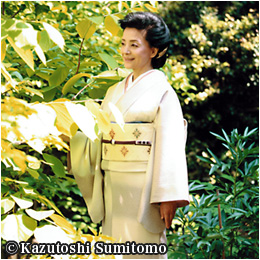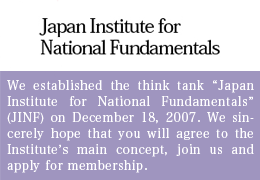Japan Needs Full-Fledged National Military Force in View of the Chinese Threat
As an independent and sovereign nation, how should Japan cope with the multitude of threats which now assail it from all sides? I eagerly look forward to the lower house election slated for December 16, as its outcome will determine the basic posture Japan will assume under a new administration vis-à-vis this vital question. It is imperative that, during this election campaign, each political party explain how it intends to strengthen our fragile national defenses, while also discussing how to tackle a host of other chronic problems, including the economic and energy policy.
The incumbent Democratic Party of Japan (DPJ), as well as some of the mass media, have thus far refused to discuss a broader picture of Japan’s national defense framework while intensifying their criticism of a proposal by Shinzo Abe (head of the Liberal Democratic Party) to form a full-fledged military force in place of the current Self-Defense Forces (SDF). Those kind of objections are utterly irrelevant in view of what China is up to in terms of its territorial ambitions across the Asia-Pacific.
The seriousness of the threat over the next ten years from China’s new regime led by Xi Jinping is obvious from what outgoing President Hu Jintao and Xi stated in their addresses during the CCP’s 18th congress held in Beijing in November.
Hu delivered a lengthy and wide-ranging opening address, stressing:
–China will continue to “improve the socialist system of laws with Chinese characteristics” and “consolidate and develop the broadest possible patriotic united front”;
–The Chinese must continue to strive to achieve “the great renewal of the Chinese nation” based on a spirit of socialistic nation building by boosting the spirit of the people and responding to the spirit of the times;
–It is important for the CCP to keep a tight grip on its “art of leadership and governorship,” especially in connection with pursuing ideological operations;
–China will achieve a major development “in the modernization of its national defense and military,” reaching a superior level of mechanization and information system by 2020; and,
–China will attach “great importance to maritime, space, and cyber security, and make active planning for the use of military forces in peacetime, expand and intensify military preparedness, and enhance the capability to accomplish a wide range of military tasks,” including armed conflict.
On the last day of the seven-day congress, Xi, who was appointed secretary general of the party as well as simultaneously named chairman of the Central Military Commission, delivered an address in response to Hu’s in which he referred to “the party” 20 times. Two days later, during an enlarged meeting of the Central Military Commission, Xi vowed to prioritize “military preparedness for armed conflict.”
Responding to the hawkish remarks by Xi, who clearly has more power than Hu and Jiang Zeming did when they became general secretary, there were visible signs of elation within the People’s Liberation Army. Here are some of the tough measures China has quickly worked out since Xi took over as the new party chief:
Hosono’s Remarks Simply Do Not Make Sense
–On November 25, The People’s Daily dramatically reports on the “success” of China’s first flight landing on its new aircraft carrier, the Liaoning. A few days earlier, the state-run China Central Television reported that China had just conducted a massive naval maneuver in the East China Sea and the South China Sea, obviously with disputed islands, such as the Senkakus, in mind.
–About the same time, China issues new passports with maps showing India’s Arunachal Pradesh state in northern Kashmir and the Himalayan region of Aksai Chin as part of China.
–Liu Xigui, Director of China’s State Oceanic Administration (SOA), announces that Chinese state patrol ships will continue operating in the waters around the Sensakus (the Diaoyus in Chinese) indefinitely, adding that the Chinese Navy will transfer a large number of its active warships to the SOA to reinforce its fleet.
–Major General Luo Yuang, executive director of the China Military Science Society, states: “Any solution to the Diaoyu issue will ultimately rest on increased Chinese military capabilities.”
Each of these Chinese actions can be construed as a manifestation of China’s readiness under the Xi regime to effectively continue an aggressive deployment of its forces in the East China Sea, especially around the Senkakus, as well as in the South China Sea. If that situation continues to prevail, the gap of military capabilities between China and Japan in that region can be expected to be 10 to 1 in China’s favor by 2030, according to reliable sources.
Japan must expeditiously review its national defense system. As matters stand now, Japan may not be able to sufficiently safeguard its sovereignty over the Senkakus because the SDF is under considerable constraints attributable to the constitution as well as certain domestic laws. A fundamental review of these restrictions is urgently called for. Also mandatory is a substantial increase in the defense budget, as an upgrading and expansion of our military capabilities is long overdue.
After scrutinizing Japan’s precarious security preparedness, the LDP drafted a revision of the Japanese constitution last April, advocating the creation of a full-fledged military force that would replace the SDF. LDP President ShinzoAbe also proposed a sizable increase in the 2013 defense budget. These, in my opinion, are logical steps to take. And yet, strong objections have been voiced by the DPJ, with Prime Minister Yoshihiko Noda and Goshi Hosono, chairman of the DPJ’s Policy Research Commission, making comments that were totally off the mark. This from a party that has yet to even draft a tentative plan for a constitutional revision.
Noda has criticized Abe, noting: “Mr. Abe says that such a full-fledged military force can be readily put in place…But I wonder if that is as easy as he implies.”
Frankly, I know Abe did not describe the actual creation of the proposed military as something that could be done ‘quickly’; in point of fact, he has repeatedly noted that he is determined to resort to “a democratic process” in realizing the birth of the new military. We all know democracy calls for time-consuming processes. For Noda as prime minister to try and shift the point at issue and criticize a pertinent initiative advanced by the head of the opposition party is tantamount to inviting a national security crisis.
Hosono’s remarks are also difficult to figure out. In a weekend television talk show recently, he proudly contended that the government party’s defense strategy has shifted from a “basic defense force” concept advocated by the LDP to a concept based on rebalancing the force, explaining that it has made Japan more versatile in coping with security threats. During a lower house budget committee deliberation in the Diet, Hosono extracted from Defense Minister Satoshi Morimoto the following statements regarding the government’s defense posture in terms of how it differs from the LDP’s:
Under LDP rule, which ended in 2009 when the DPJ came to power, Japan stuck to a policy of maintaining deterrence with a minimum level of military capabilities by merely deploying troops with standard equipment evenly across the Japanese archipelago, rather than consolidating them in specific areas to cope more directly, collectively, and effectively with threats in the peripheral regions of the country. The DPJ switched to the “rebalancing” initiative, which its proponents claim will prove effective especially in the defense of outlying islands, such as the Nansei Islands – a chain of volcanic islands stretching from Kyushu to Taiwan.
Nothing but Trickery with Words
In his zeal to defend the DPJ’s defense policy, Hosono sang the praises of the new defense concept. But I wonder if it is as solid as it is purported to be. The defense budget should have substantially been increased but, the DPJ decided to hold the 2012 defense outlay roughly at the same level as 2011, failing to bring up to scratch the personnel and equipment envisioned under the National Defense Program Outline. Should an emergency develop, say, in the Nansei region, SDF troops based in the north likely will have to be deployed as a stop-gap measure. That is one of the sorry aspects of the rebalancing defense initiative.
I claim to be reasonably well informed of the efforts made by Deputy Defense Minister Akihisa Nagashima and his DPJ colleagues to upgrade Japan’s national defenses. Despite their efforts, however, I have to sadly declare that the DPJ’s defense policy in the absence of sufficient defense budget is nothing but trickery with words. People in Japan have not forgotten the erratic national security policy persistently pursued by the DPJ since 2009, when Yukio Hatoyama became its first prime minister, doing considerable damage to US-Japan relations. It simply doesn’t make sense for any member of the DPJ to be speaking proudly of its defense initiative, which to me is plain trickery.
Hosono has also made these naïve remarks:
“Recently, I had a chance to discuss matters about our nation’s defense issues with friends from China and the US…I was surprised that some of the American visitors expressed pretty strong concern about the (LDP’s) proposal for a full-fledged military force.”
No doubt China will express “serious concern” over any plans in Japan to create a full-fledged military force, while shutting its eyes to its own abnormal military expansion. Similarly, there must certainly be those in the US who would not take too kindly to such a Japanese initiative.
Setting China aside, I do believe there will be some Americans who will also welcome any gesture of Japanese efforts toward creating such a military force as a step towards making Japan a normal independent nation. I wonder if Mr. Hosono may not have such American friends he can rub elbows freely with. To put it more bluntly, does he ever recognize the threat from China?
Hosono has also mentioned that “creating a full-fledged military force is considerably removed from the reality of today’s Japan in terms of both public opinion and the actual state of affairs in this country.” I couldn’t believe my ears when I heard him say this. Isn’t he by any chance aware that the biggest concern among Asian nations today is how to cope with the steadily growing threats from China? Whether we like it or not, Japan has already been forced into an arena of international politics in which its sovereignty is at stake, much in the same way as other Asian nations who have seen their territorial land and seas put in jeopardy by China.
Against such a backdrop, the criticism by Messrs. Noda and Hosono of the proposal to create a full-fledged military force simply reflects their appalling lack of awareness of the grave crisis that confronts not only Japan but all of Asia. What the Japanese desperately need now is a sound spirit with which to safeguard the nation’s sovereignty and integrity, along with the birth of a well-functioning and full-fledged military force which in turn will support that spirit.
(Translated from “Renaissance Japan” column no. 537 in the December 6, 2012 issue of The Weekly Shincho)








